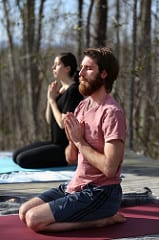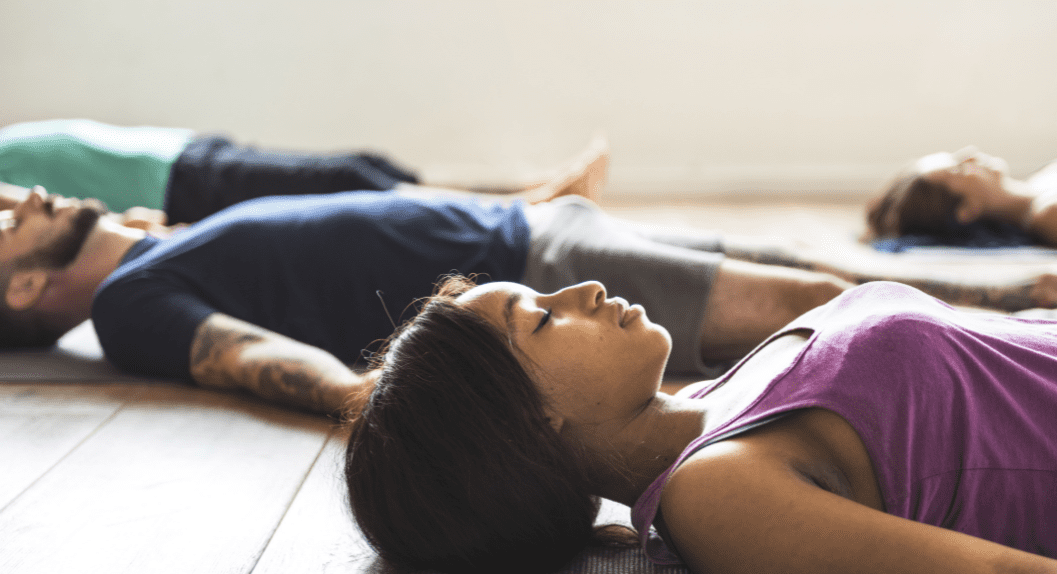The following is an excerpt from Michael Rhadeya Plasha’s memoir, The Amazing Adventures of a Yogi in America. In it, he attempts to find the most accurate definitions of traditional Yoga, shares his personal journey of teaching Yoga, and describes his experience of Yoga’s healing power. To read more of Michael’s story, check out his blog for the full memoir.
The Play of Yoga and Meditation
What is Yoga? I discovered many different definitions of Yoga in these ancient texts. How do you define Yoga? Today, the common perception and understanding are that Yoga is for stretching or a way to workout. Today, I hear that Yoga is having a strong and flexible body. Or Yoga is sweating to purify the body. Yoga is for stress management. Yoga is for relaxing. Yoga is good for overall health. And if you practice enough postures you might become happy. All relatively true.

Pranayama—one of the more subtle Yoga practices.
The American fitness culture embraced the physical side of Yoga in the 90’s. The psychological, philosophical, and spiritual roots of traditional Yoga were usually removed. Ninety minute classes were reduced to 60 or 45 minutes to accommodate gym schedules. The deeper practices like Yoga Nidra (deep relaxation), shavayatra (concentration, breathing, and relaxation training), pranayama (breathing practices) and meditation were cut.
Then hybrids developed to emphasize the physicality of Hatha like Pi-Yo (pilates and Yoga), Core Fusion (barre or pole fitness and postures), Yoga Sculpt (with hand weights), Aerial Yoga (cloth hammocks for suspension), Hot Power Yoga (sweaty speed flows and pushups), Trampoline Yoga, and Yoga Fit using exercise balls. Here’s a recent one: Vinyasa/Yin Power Sculpt—a combination of Yoga, cardio, and weights. I wonder why the timeless teachings of traditional Yoga are not enough for some teachers. They feel a need to add non-Yoga practices like loud, recorded contemporary pop music, essential oils, massage, Reiki and light shows. There are even Ganja Yoga studios in Colorado now!
These hybrids and postural Yoga styles have benefits. The focus, like any fitness goal, is usually a stronger and thinner body. This intention can play into America’s obsession with the body and movement. That has its place, but from my perspective, that is selling Yoga short. Sure, I want a stronger and slightly thinner body, too, but I primarily want peace of mind and an open heart. I want liberation from my ego, the cause of suffering.
My idea of a “hybrid” has been to try to integrate the aspects of the four major paths of Yoga: Bhakti (the Yoga of love and devotion), Karma (the Yoga of selfless service), Jnana (the Yoga of Self-inquiry) and Raja (the Yoga of ethical and moral virtue, mastery of the mind, and concentration and meditation techniques). Years later I learned in my first major training that Swami Satchidananda once said, “Hatha Yoga is a calling card of Raja Yoga.” This idea lit up for me and I have been inspired ever since to teach Hatha in the context of these other Yoga paths.
The traditional role ofasana was to slow the body down and internalize awareness as an embodied practice. The postures were held much longer than a few breaths. I had heard that the Yogic sages considered the “perfect” pose to be one you could hold for three hours! I am glad they were referring to meditative poses and not cultural ones.
Some of the traditional definitions and goals of Yoga I found in my readings included:
- Yoga is spiritual union.
- Yoga is discipline.
- Yoga is when the senses are firmly under control.
- Yoga is evenness of mind.
- Yoga is skill in action.
- Yoga is absence of pain.
- Yoga is the attainment of liberation.
- Yoga is the stilling of all thought.
- Yoga is transcendence.
- Yoga is an expression of Vedic Dharma (holistic and enlightened living).
These goals are what have always inspired my practice and what I occasionally experienced. The benefits are radically different than the popular fixation on a lean, postural Yoga body. Years later I experienced the power of these teachings with students. One time I was teaching a series of classes in the café at Wegman’s grocery store. Yes, a grocery store. This was during a time I was teaching all over town in many settings to develop an interest in Yoga. This was not easy in a primarily conservative, Catholic, blue-collar town. I was desperate. I was not always welcomed. I was ridiculed by some. This was 1994-1997.
Some people told me if I taught chanting, meditation, and that “mumbo jumbo” philosophy, I would never make it. There were still only a few Yoga teachers around. I was the first to become certified from a teacher training by the Integral Yoga Institute in 96. It exceeded the 200 hours that was later set by the Yoga Alliance for minimum standards for teachers.
Anyway, we were supposed to be in the café but there was a disruption so we moved to a storage room. There were about 12 students, including my dad, who was about 79 at the time. He was hoping to meet some new ladies. Go dad! He had been widowed for a long time. After the class, which included the traditional practice of Yoga Nidra that might be missing from athletic styles of postural Yoga, a woman came up to me and said, “Is it okay that I left my body? I felt like I was levitating and could see the class below me. It felt very peaceful, like maybe what heaven is like.”
Miracles indeed! I told her it doesn’t get much better than that and if it never happened again, to contemplate its significance. I would like to think Paramahansa Yogananda and other Yoga masters were smiling somewhere. These miracles may not happen if we do not slow down.
Slowing down is uncomfortable for some. The latest statistics show that one out of four Americans have experienced trauma. This could be emotional, psychological, physical, or sexual. One out of four Yoga students in a class, whether they have forgotten or remembered, may be holding trauma in their bodies. When we slow down there is the potential for emotions, sensations, or memories to surface as a result. You might know the saying, “We hold our issues in our tissues.” Therefore, some people choose to not slow down and distract themselves by being busy—the dis-ease of busyness—which may create disease. We may distract ourselves, numb out, or keep moving quickly to avoid the discomfort. This is my theory why flow classes are so popular today.
It is hard for some folks to slow down. My Ayurveda teacher, David Frawley, described the fifteen to sixty-minute practice of Yoga Nidra in Shavian as a deep practice of being, and that being is healing—not doing or becoming. Today, a flow or speed Yoga class might end with five minutes in shavasana with music still playing! However, I feel it is compassionate to meet people halfway. Expecting someone to sit or lie down for 60 minutes may be too much. Sixty minutes of movement followed by 30 minutes of internalized practices might be more accommodating.
As difficult as it was for me to slow down with meditation, I began to experience its healing power. For over a year, I would feel very uncomfortable while meditating. I would feel waves of grief, fear, and anger. I would cry for no apparent reason. The unconsciousness was becoming conscious and I was releasing repressed and suppressed emotional wounds and memories. I was healing. I call it taking out the garbage. I was doing the work to be.

Meditation is one branch of the 8-limbed path of Yoga.
One of my Zen teachers in the 70’s used to say you were not meditating until you cried during meditation. Apparently, I was going deep! Eventually the mental chatter and emotional waves began to settle. I was meditating on the breath. If my mind wandered, I would note the distraction-like thinking and return to the breath. I noticed the pause after each out-breath before the in-breath was born. During the pause, I was aware of stillness and silence. It was magical! For a few seconds, I was aware of not thinking.
Some Yoga Sutra commentators have mentioned this with YS: 2:50 and 51.“Pranayama manifests as external, internal, and restrained movements of breath. These are drawn out and subtle in accordance to place, time, and number. The fourth type of pranayamasurpasses the limits of the external and the internal.”
Kumbhaka means breath retention. Antar kumbhaka is internal breath retention and is contraindicated if one has hypertension. Bahir kumbhaka is external breath retention and may be contraindicated with low blood pressure. I was experiencing spontaneous bahir kumbhaka. The feeling was mental peace. Thus, I noticed I was becoming more intuitive. I would usually use logic and empirical knowledge to solve problems and address challenges. When I could “mentally pause,” I would intuit what to do next. This was a radical change from how I had always made decisions.
For the first time, I was noticing synchronicity in my life. I think it was always there but I began to see it and to see it more often as I let go of controlling every detail of my life. My final years at college and the beginning of a career and raising a family would give me many opportunities to navigate the balance of the logical and intuitive mind.



